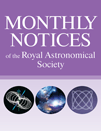Mechanical equilibrium of hot, large-scale magnetic loops on T Tauri stars
ABSTRACT
The most extended, closed magnetic loops inferred on T Tauri stars confine hot, X-ray-emitting plasma at distances from the stellar surface beyond the X-ray-bright corona and closed large-scale field, distances comparable to the corotation radius. Mechanical equilibrium models have shown that dense condensations, or ‘slingshot prominences’, can rise to great heights due to their density and temperatures cooler than their environs. On T Tauri stars, however, we detect plasma at temperatures hotter than the ambient coronal temperature. By previous model results, these loops should not reach the inferred heights of tens of stellar radii where they likely no longer have the support of the external field against magnetic tension. In this work, we consider the effects of a stellar wind and show that indeed hot loops that are negatively buoyant can attain a mechanical equilibrium at heights above the typical extent of the closed corona and the corotation radius.




